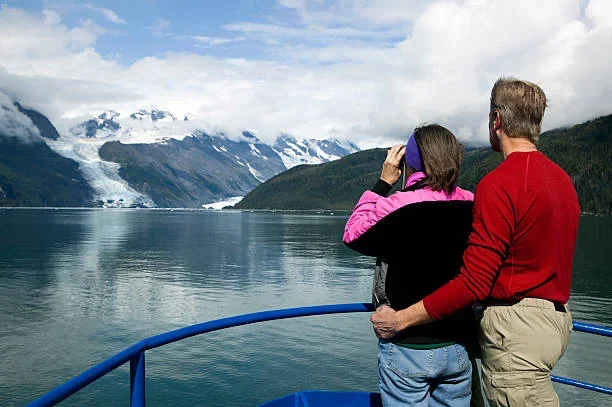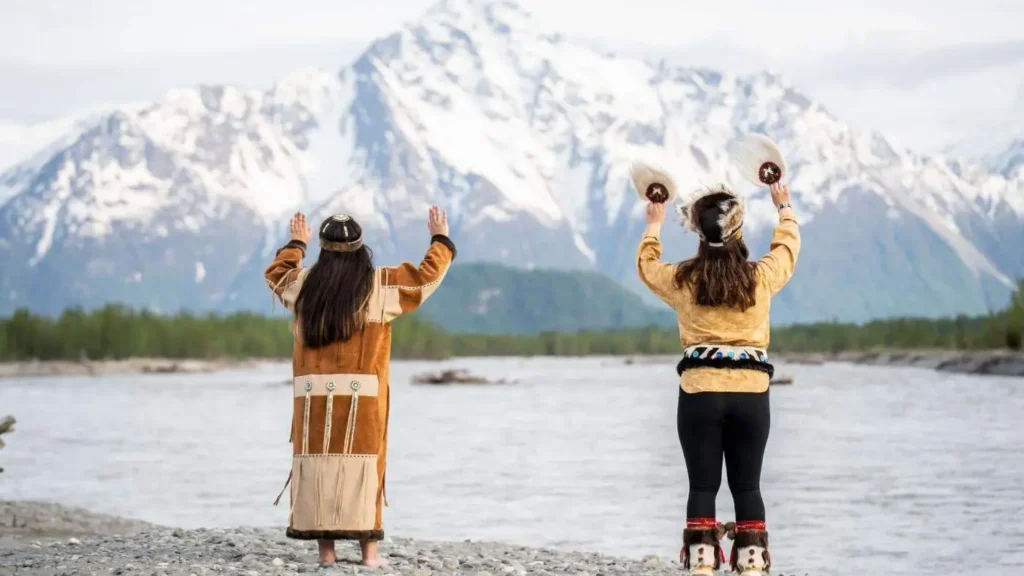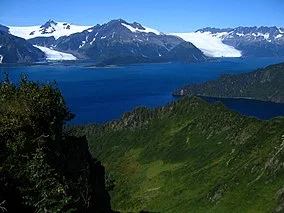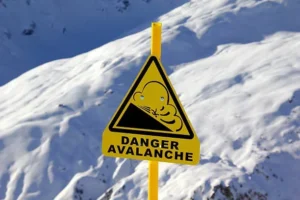I still remember my first visit, the crisp mountain air and the quiet beauty of Denali left me speechless. National parks in Alaska offer a little bit of everything: thrilling hikes, peaceful boat rides, and even up-close encounters with bears and moose (from a safe distance, of course).
Table of Contents
Why Alaskan National Parks Are a Must-Visit
You’ll be amazed by the views: Towering mountains, shining glaciers, and endless wilderness, it’s a view that will stay with you forever. I remember standing in Denali, feeling like I was in a completely different world.

Wildlife you’ll never forget: From bears catching salmon to moose grazing near the trails, Alaska’s parks bring you closer to nature than you’ve ever been. I once spotted a bald eagle soaring right above me.

Endless adventures await: Whether you’re hiking, kayaking, or even just taking a scenic drive, the parks have so much to offer. Walking on a glacier in Kenai Fjords was one of the coolest experiences of my life.

You’ll connect with culture: These parks aren’t just about nature; they’re also rich with Indigenous history and traditions. Visiting Totem Bight State Historical Park gave me a whole new appreciation for Alaska’s heritage.

Unforgettable moments you can’t get anywhere else: Watching the Northern Lights dance across the sky or hearing the thunder of a calving glacier, these are once-in-a-lifetime experiences you’ll find here.

- So much room to explore: Alaska’s parks are huge, and the solitude you’ll find is unmatched. I once hiked for hours in Wrangell-St. Elias without seeing another soul, it was pure peace.
- Perfect for everyone: Whether you’re an experienced adventurer or just want to soak in the views, Alaska’s parks offer something for all types of travelers.
💡 How Many National Parks Are There In Alaska?
Each offering unique landscapes and experiences that showcase the state’s incredible natural beauty and diversity.
List of Best Alaskan National Parks
| National Parks | Highlights | Views |
| 1- Denali National Park | Home to North America’s tallest peak, Mount Denali (20,310 ft). |  |
| 2- Glacier Bay National Park | Features dramatic glaciers and fjords; part of a UNESCO World Heritage Site. |  |
| 3- Kenai Fjords National Park | Known for its glaciers flowing from Harding Icefield into the sea. |  |
| 4- Wrangell-St. Elias National Park | Largest national park in the U.S. (13.2 million acres); diverse ecosystems. |  |
| 5- Katmai National Park | Famous for brown bears and salmon runs; Valley of Ten Thousand Smokes. |  |
| 6- Gates of the Arctic National Park | Second-largest national park in the U.S. (8.4 million acres); experiences extreme weather conditions. |  |
| 7- Lake Clark National Park | Stunning landscapes with volcanoes, lakes, and abundant wildlife. |  |
| 8- Kobuk Valley National Park | Home to the Great Kobuk Sand Dunes and migrating caribou herds. |  |
Largest National Park In Alaska
Why Wrangell-St. Elias Stands Out:
- Vast Wilderness: The park encompasses four major mountain ranges, including the Wrangell, St. Elias, Chugach, and Alaska Ranges, offering incredible landscapes of mountains, glaciers, and valleys.
- Unparalleled Adventure: With its remote location and size, it’s a paradise for climbers, hikers, and backcountry explorers seeking solitude and pristine nature.
- Cultural and Geological Significance: The park includes historic mining sites and is home to the largest concentration of glaciers in North America.
Activities in Alaska National Parks
1- Hiking in Alaska Parks
Hiking in Alaska is a must-do, but it’s not your average stroll in the park. Always wear sturdy boots and dress in layers—you never know when the weather might change. Stick to marked trails like the Savage River Loop in Denali if you’re new to hiking. For more experienced hikers, Harding Icefield Trail in Kenai Fjords offers breathtaking glacier views, but be ready for steep climbs.
–Do’s: Carry a map, plenty of water, and snacks. Always check trail conditions beforehand.
-Don’ts: Avoid wandering off-trail; it’s easy to get lost in the vast wilderness.
2- Camping in Alaskan National Parks
Camping in Alaska is a raw, exhilarating experience. Choose a designated campground like Riley Creek in Denali or go for backcountry camping if you’re feeling adventurous. Always store food in bear-proof containers and keep your campsite clean.
–Do’s: Bring a good sleeping bag rated for cold weather, even in summer.
–Don’ts: Never leave food unattended, and avoid setting up camp near animal trails or water sources.
3- Photography of Scenic View in Alaska Parks
Alaska is a photographer’s paradise, but timing is everything. For the best light, head out early in the morning or late in the evening. Bring a tripod for long-exposure shots of the Northern Lights or to steady your camera for wildlife photos.
-Do’s: Use a zoom lens for wildlife and wide-angle lenses for landscapes.
–Don’ts: Don’t rush your shots—Alaska rewards patience with jaw-dropping moments.
4- Wildlife in National Parks
Spotting a grizzly bear or a moose in its natural habitat is thrilling, but safety is key. To watch Alaska’s national parks always keep a safe distance—use binoculars or a zoom lens to get a closer look. In places like Katmai National Park, follow all ranger instructions when near bears.
–Do’s: Make noise while hiking to avoid surprising animals. Carry bear spray as a precaution.
-Don’ts: Never feed or approach wildlife—it’s dangerous for you and harmful to them.
5- National Park Adventures in Alaska
From glacier trekking to ranger-led tours, Alaska offers activities you can’t find anywhere else. If you’re up for a challenge, try walking on a glacier in Wrangell-St. Elias or kayaking in Kenai Fjords. These activities require a guide, so book in advance.
–Do’s: Wear proper gear, like crampons for glacier walks, and listen carefully to your guide.
–Don’ts: Don’t attempt risky activities without proper training or guidance.
6- Boating and Kayaking: Explore Alaska’s Waters
Water adventures are a must, but they require preparation. Kayaking through fjords or taking a boat tour in Glacier Bay lets you see Alaska from a unique perspective. Always wear a life jacket and watch for changing tides.
–Do’s: Dress in waterproof layers and carry a dry bag for essentials. Book guided tours if you’re new to kayaking.
–Don’ts: Don’t venture out in bad weather or without checking tide schedules—it can be dangerous.
7- Snowshoeing And Dog Sledding
Snowshoeing and dog sledding are quintessential Alaskan experiences. Dress warmly in insulated layers and bring hand warmers for extra comfort. If you’re trying dog sledding, make sure to book with a reputable operator for a safe and ethical experience.
–Do’s: Learn basic snow safety and carry a map or GPS for snowshoeing.
–Don’ts: Don’t underestimate the cold—frostbite can sneak up on you quickly.
How to Visit Alaskan National Parks
Visiting Alaska’s national parks requires planning due to their remote locations and vast landscapes. Here’s how to visit National Parks of Alaska
- Choose the Right Time: Visit during summer (June–August) for better weather, accessible trails, and active wildlife.
- Plan Transportation: Many parks are accessible by car, ferry, or plane. Remote parks like Gates of the Arctic or Katmai may require small charter flights or boat trips.
- Decide on Activities: Research activities like hiking, wildlife viewing, or glacier exploration specific to each park.
- Obtain Necessary Permits: Some parks require camping or backcountry permits, especially for popular areas.
- Use an Alaska National Parks Map: Plan routes, locate visitor centers, and identify key attractions using a detailed map.
- Consider Guided Tours: Opt for guided tours for convenience and expert insights, especially if it’s your first visit.
- Prepare for the Wilderness: Pack essentials for Alaska’s unpredictable weather and rugged conditions, including sturdy footwear, layers, and insect repellent.
💡Wildlife Viewing in Alaska National Parks💡

Alaska’s national parks offer top wildlife viewing opportunities, allowing visitors to observe diverse animals in their natural habitats. From the majestic brown bears fishing for salmon in Katmai National Park to the graceful Dall sheep traversing the rugged terrains of Denali National Park, these protected areas are a haven for wildlife enthusiasts.
Bird watchers can delight in spotting bald eagles soaring above and various seabird colonies along the coastlines. Marine life, including humpback whales and sea otters, can be observed in parks like Kenai Fjords. To ensure a safe and respectful experience, it’s essential to maintain a safe distance, remain patient and quiet, and respect the animals’ natural behaviors.
Why is Climate Change Causing Risk to Wildlife?
Alaska’s national parks are experiencing significant transformations due to climate change, with rising temperatures leading to the retreat of glaciers, thawing of permafrost, and disruptions in ecosystems. Over the past 60 years, Alaska has warmed by an average of 3°F (1.7°C), more than twice the global average, with winters seeing an increase of 6°F (3.3°C).
This warming has resulted in the accelerated melting of glaciers in parks like Denali and Glacier Bay, threatening wildlife habitats and water sources. Additionally, the thawing of permafrost, which underlies much of the region, poses risks to infrastructure and releases stored greenhouse gases, further exacerbating climate change.
The shifting climate change affect Alaska’s wildlife, leading to changes in migration patterns, food availability, and habitat loss. Species such as polar bears, caribou, and migratory birds are facing challenges as their traditional feeding and breeding grounds are altered by rising temperatures and diminishing ice coverage.

Camping In Alaska National Parks
Alaska’s national parks offer incredible camping opportunities, from the rugged backcountry of Denali National Park to the coastal beauty of Glacier Bay. Camping in remote areas of Alaska requires careful planning and preparation to ensure a safe and enjoyable experience.
Visitors should familiarize themselves with park-specific regulations, obtain necessary permits, and be ready for unpredictable weather conditions, including cold temperatures and sudden storms. Proper gear, such as bear-proof food containers and layered clothing, is essential for staying safe in the wilderness.
Many parks offer both developed campgrounds with basic amenities and primitive sites for those seeking solitude and adventure. Additionally, wildlife encounters are common, making it important to follow safety guidelines and practice Leave No Trace principles to protect the environment and preserve the parks’ natural beauty for future generations.

Planning Your Alaska National Parks Trip
When you plan a trip to Alaska National Parks, consider the best times to visit each park based on seasonal activities. Summer typically has the highest visitor numbers due to milder weather and accessible trails. Popular tour options include guided bus tours in Denali or boat tours in Glacier Bay, allowing travelers to experience these incredible landscapes with expert guidance.
FAQs
Each year, millions of visitors travel to Alaska, drawn by its incredible wilderness and national parks. Most travelers come during the summer months, with June, July, and August being the busiest times.
- Seasonal Peaks – Summer is the most popular season for park visits.
- Visitor Demographics – Families, solo travelers, and adventure groups.
- Tour Numbers – Guided tours host thousands of participants every year.
Remote parks can be accessed via small planes, boats, or guided tours, as most lack road access. Planes are the most common mode of transportation.
Expect to see brown bears, moose, caribou, bald eagles, wolves, and whales, depending on the park and season.
Yes, guided tours are widely available and highly recommended for first-time visitors. These tours provide expert insights and ensure safety in remote areas.
Costs vary but typically include park entry fees ($10–$15 per person), transportation, and optional guided tours or accommodations. Guided tours can range from $100 to $500+ depending on the experience.













